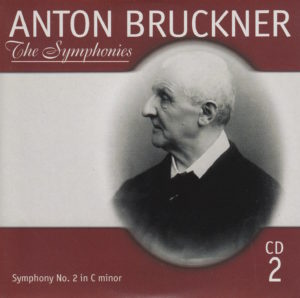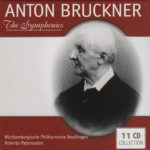 This morning’s conductor of Anton Bruckner’s “Symphony of Pauses” (Symphony No. 2 in C Minor, WAB 102) is Vienna-born Roberto Paternostro (1957?-), another person about whom I knew nothing and of whom I had never heard until I started this project.
This morning’s conductor of Anton Bruckner’s “Symphony of Pauses” (Symphony No. 2 in C Minor, WAB 102) is Vienna-born Roberto Paternostro (1957?-), another person about whom I knew nothing and of whom I had never heard until I started this project.
Here’s what I wrote the about him on Day 11:
Given how little there is about him online – including a compelling biography that includes (at the very least) his date of birth – I’m going to go out on a limb and say he’s not ever going to be well known until he at least has an English-language entry on Wikipedia. I do believe there is a Wiki entry for him, but it’s in German. So I can only guess that his date of birth is 1957. Very little else (in fact, nothing else) on that page is decipherable, at least to me.
Paternostro needs a publicist in the worst way.
 The same challenges I encountered with Paternostro and Bruckner’s First Symphony, I will encounter for the next seven symphonies: scant information, not even info about the version of the symphony he’s conducting. No bio on himself. No bio on Bruckner or background on the symphonies. Zip. Zero. Nada.
The same challenges I encountered with Paternostro and Bruckner’s First Symphony, I will encounter for the next seven symphonies: scant information, not even info about the version of the symphony he’s conducting. No bio on himself. No bio on Bruckner or background on the symphonies. Zip. Zero. Nada.
Here’s what I do know:
Anton Bruckner was 48 when he published it in 1872
Symphony No. 2 in C Minor is it’s name, nicknamed: “The Symphony of Pauses”
Conducted by Roberto Paternostro
Orchestra is Wurttembergische Philharmonie Reutlingen (web site in German)
Recorded in July of 1997.
Recorded in Basilika Weingarten (Wiki page in German)
The running time for each movement
The total running time for the symphony
Membran record label
And that’s it.
Bruckner wrote his symphonies in four parts. The time breakdown of this one (Symphony No. 2 in C Minor, Edition unknown), from this particular conductor (Paternostro) and this particular orchestra (Wurttembergische Philharmonie Reutlingen) is as follows:
Moderato………….18:39
Adagio……………….14:50
Scherzo……………….7:08
Finale…………………17:26
Total: 58:02
Okay. Now for the subjective aspects to this morning’s listening:
My Rating:
Recording quality: 3
Overall musicianship: 4
CD liner notes: 0 (there are none – boo! hiss!)
How does this make me feel: 3
In some ways, this is a fine performance.
However, there are a few things about it that rankle me.
1. No information about what’s being played. Which version of the Second Symphony? Who is Roberto Paternostro? Why is he conducting this music? Does he have an affinity for doing so? Does he like Bruckner?
2. The sound in this recording is cavernous. The reverb that one hears at a sudden full stop (all silent) is amazing. It sounds like this was recorded in a huge shower somewhere. Lots of echo.
3. The French horn during Movement II (Andante) isn’t as mellow or as confident as the player in, for example, the Karajan recording or the Jochum recordings (especially the recording with the in the green box – Day 23 for those following along at home). The first time my favorite pizzicato and French horn passage appears, the horn sounds hesitant. That’s why I suggested the word “confident.”
4. The ambient sounds – for example :52 into Movement II, somebody drops something metallic that bounces – a coin, perhaps? Other times, I can hear people coughing or sniffing or shuffling. It’s not major. But each time I hear that, I’m taken out of the performance.
5. The applause at the end of the fourth movement (Finale). It lasts for about 45-60 seconds. I prefer no applause, frankly. In a recorded symphony it takes me out of my reverie. I want to applaud internally if I think the music warrants it.
Other than that, this is a serviceable recording that gets the job done. It’s not my favorite. It’s not my least favorite.
